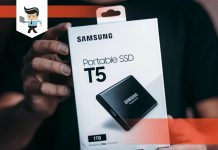The difference between Samsung 840 EVO and 850 EVO is mainly related to the read and write speed, their capacities, and the write endurance of the drive.
 Both are internal solid-state drives two and a half inches wide and designed to go inside the case of the computer as the main drive or backup drive. Find below a comparison of the two drives and the advantages and disadvantages of each.
Both are internal solid-state drives two and a half inches wide and designed to go inside the case of the computer as the main drive or backup drive. Find below a comparison of the two drives and the advantages and disadvantages of each.
Contents
840 EVO vs 850 EVO Specifications
|
|
Samsung 850 EVO | Samsung 840 EVO |
| Capacity | 120 GB, 250 GB, 500 GB, 1 TB, 4TB | 120 GB, 250 GB, 500 GB, 750 GB, 1 TB |
| Connection | SATA | USB, SATA, mSATA |
| Feature | Solid State Drive | Solid State Drive |
| Form Factor | 2.5 Inch Drive | 2.5 Inch Drive |
| Type | Internal | Internal |
1. Samsung 840 EVO
Connections: USB, SATA, mSATA
Features: 2.5 Inch Internal drive
Design aesthetics: Silver drive
Considerations:
- Single layer chips
- Older technology
- Smaller chips
- Shorter lifespan
- 3 Year Warranty
The Samsung 840 EVO has three available connections depending on the type of motherboard you have, but if you have the ability to use SATA over USB, you are going to want to do so to take advantage of the speed.
Both SATA and mSATA meet the requirements of 6 Gb/s but USB only reaches 5 Gb/s. If you only have the space to use mSATA, this drive can accommodate that requirement.
As the internals of a computer are increasingly put on display with windowed cases and full-color spectrum components, the design aesthetic of the Samsung 840 EVO is something to consider as well. The 2.5 inch drive is housed in a silver casing which will reflect light from any RGB components and contribute to the colored interior of the computer.
The Samsung 840 EVO uses older, single-layer chip technology which means it takes longer for the drive to communicate with the computer you are using.
addition to having slower read and write speeds, the Samsung 840 EVO lifespan is shorter than the Samsung 850 EVO. The Samsung 840 EVO can only endure approximately 3000 write cycles as opposed to 6000 with the Samsung 850 EVO

If reliability and warranty is something you look for in your drive, then be aware that the Samsung 840 EVO only comes with a 3-year warranty when its competitor the Samsung 850 EVO comes with five.
2. Samsung 850 EVO
Connections: SATA
Features: 2.5 Inch Internal Drive
Design Aesthetics: Black drive
Considerations:
- Larger chips
- Stacked 32 layers deep
- Longer lifespan
- Faster memory access
- 5 Year Warranty
Unlike the Samsung 840 EVO, the Samsung 850 EVO only accommodates connection by SATA. This eliminates the choice between running the drive over USB vs SATA, but also means that this drive cannot use the smaller, mSATA connection.
The design aesthetic of the Samsung 850 EVO is something to consider as well in the world of computer cases with windowed sides. The 2.5 inch drive is housed in a black casing, which will blend with the sleek and seamless look of high-end gaming set up with other black components.
The chips in the Samsung 850 EVO are stacked which reduces the physical distance between the silicon layers and increases the speeds at which data can be accessed from the drive.

The Samsung 850 EVO also boasts a 5 year warranty covering the drive, giving the buyer extended peace of mind with regard to reliability, in contrast to the 3-year warranty available with the Samsung 840 EVO.
Samsung 840 EVO and 850 EVO Benchmark data
The main difference between 840 EVO and 850 EVO is, Samsung 840 EVO Faster read speed on larger drives while Samsung 850 EVO has faster read and write speed, both random and sequential.
1. Samsung 840 EVO Performance
| 120 GB | 250 GB | 500 GB | 750 GB | 1 TB | |
| Random Read (higher is better) | 91.7 MB/s | 94 MB/s | 90 MB/s | 95.3 MB/s | 96 MB/s |
| Random Write (higher is better) | 147.8 MB/s | 266.4 MB/s | 270.3 MB/s | 272.9 MB/s | 271.9 MB/s |
| Sequential Read (higher is better) | 429.8 MB/s | 426.8 MB/s | 409.8 MB/s | 405.7 MB/s | 428.7 MB/s |
| Sequential Write (higher is better) | 172.9 | 285.8 MB/s | 375 MB/s | 375.7 MB/s | 374 MB/s |
| Turbo Write Cache | 3 GB | 3 GB | 6 GB | 9 GB | 12 GB |
| Die Configuration | 8 x 128 GB | 16 x 128 GB | 32 x 128 GB | 48 x 128 GB | 64 x 128 GB |
– Samsung 840 EVO Benchmark
The four elements of SSD performance are generally considered to be the following: random read speed, random write speed, sequential read speed, and sequential write speed. Random accesses are generally small, and sequential accesses are generally larger, but that does not necessarily mean random reads and writes are faster than their sequential counterparts.
Compared to the Samsung 850 EVO, the Samsung 840 EVO has the following advantages:
- Faster read speed on larger drives
Comparing the different sizes of the Samsung 840 EVO, they have the disadvantage of their 120 GB drive and their 1 TB drive of not performing as well as the 250 GB, the 500 GB, and the 750 GB drives. For the Samsung 840 EVO, the drive size with the best overall performance is the 750 GB drive.
The EVO 840 has a random read between 90 and 96 MB/s, and the 1 TB Samsung EVO 840 generally performs better in both the random and sequential read than the comparable 1 TB Samsung EVO 850. Despite the fact that the Samsung EVO 840 outperforms the Samsung EVO 850 at that size, the overall performance of the Samsung 840 EVO drops off when comparing the Samsung EVO 840 750 GB drive to the Samsung EVO 840 1 TB drive.
The EVO 840 features a second-level cache. On the 120 GB and 250 GB EVO 840 this is a 3 GB Turbowrite cache (TWC), a block of high-speed flash memory. On larger sizes another 3 GB is added to the TWC. Write speeds can drop by approximately 50% when this cache is used up, but under typical consumer read and write operations it won’t happen very often.
With eight parallel NAND channels and the ability to address four chips per channel, the EVO’s controller needs at least 32 dies for optimal performance. Therefore, only the 500GB and larger models deliver on the full potential of the drive. The 120 GB and 250 GB models predictably have lower write performance.
Because of this disadvantage in the die configuration, the 120 GB and the 250 GB sizes have the most to gain from the Turbowrite cache, though it does take up a larger portion of the drive space on the smaller drives compared to the large ones.
Looking at raw performance numbers, even with the Turbowrite cache, the EVO 840 still doesn’t reach the speeds of some of the fastest drives on the market. It has a speed index reading of 439 MB/s which puts the EVO 840 within striking distance of the two speed leaders (Vector and 850 Pro). The Samsung EVO 840 is cheaper than the Samsung EVO 850, and it is one of the best values for the cost of an internal SSD.
2. Samsung 850 EVO Performance
| 120 GB | 250 GB | 500 GB | 1 TB | |
| Random Read (higher is better) | 101.6 MB/s | 103.9 MB/s | 104.5 MB/s | 89.6 MB/s |
| Random Write (higher is better) | 170.2 MB/s | 298.6 MB/s | 301.7 MB/s | 285.5 MB/s |
| Sequential Read (higher is better) | 447.7 MB/s | 421 MB/s | 421.5 MB/s | 419.5 MB/s |
| Sequential Write (higher is better) | 186.8 MB/s | 320 MB/s | 391.3 MB/s | 379.1 MB/s |
– Samsung 850 EVO Benchmark
Compared to the Samsung 840 EVO, the Samsung 850 EVO has the following advantages:
- Generally faster read and write speed, both random and sequential
When considering the four elements of SSD performance: random read speed, random write speed, sequential read speed, and sequential write speed, the Samsung EVO 850 outperforms the Samsung EVO 840 in most categories at comparable sizes.
The Samsung 840 EVO only outperforms the Samsung 850 EVO at the 1 TB size. Across the board, the Samsung 850 EVO has faster random read speed, faster random write speed, faster sequential read speed and sequential write speed. The best performing size of the Samsung 850 EVO is the 500 GB drive.
Like the Samsung 840 EVO, the Samsung 850 EVO suffers a loss in performance at the 120 GB size and 1 TB size compared to the sizes in the middle. The random read speed of the 1 TB drive is only 89.6 MB/s compared to 104.5 MB/s for the 500 GB, and the sequential write speed of the 120 GB drive is only 186.8 MB/s compared to 391.3 MB/s for the 500 GB size.
The Samsung 850 EVO is one of the fastest Samsung SSDs available on the market, consistently outperforming its competitor, the Samsung 840 EVO. Thanks to Samsung’s new 3D V-NAND the 850 also generally consumes less power and performs better than both the 840 Evo and 840 Pro. These drives effectively saturate SATA 3.0 making it difficult to distinguish between them during daily use.
– Write Endurance
A solid state drive’s lifespan is measured by the number of write cycles it can undergo. The Samsung 840 EVO write endurance is approximately 3000 cycles, and on the Samsung 850 EVO this is approximately 6000 cycles.
In contrast to conventional hard drives, the mechanics of solid state don’t degrade when only reading data. This means a solid state drive only undergoes wear when writing data, not when reading it.
Samsung’s warranty includes a provision for the total amount of data written to the drive as well, which for the Samsung 850 EVO is 75 terabytes written to the drive for the 120 GB and 250 GB sizes, and 150 terabytes written for the 500 GB and 1 TB sizes.
Both drives will last several years, but the Samsung 850 EVO can withstand significantly more write cycles than the Samsung 840 EVO which adds value if you know you use your drive to do a lot of write operations over its lifetime.
Conclusion
If you know you only have use for a drive approximately 500 GB in size and read and write speed are particularly important to you, then it would be worth the extra money to get the 500 GB Samsung 850 EVO. It has the fastest read and write speeds of the Samsung 850 EVO line and is even faster than the 750 GB Samsung 840 EVO.
If you know you need a drive bigger than 500 GB and you are also looking to save a little money, the Samsung 840 EVO will be more than sufficient, particularly if you need 1 TB of storage, because this is where the Samsung 840 EVO has an advantage in speed over the Samsung 850 EVO.







